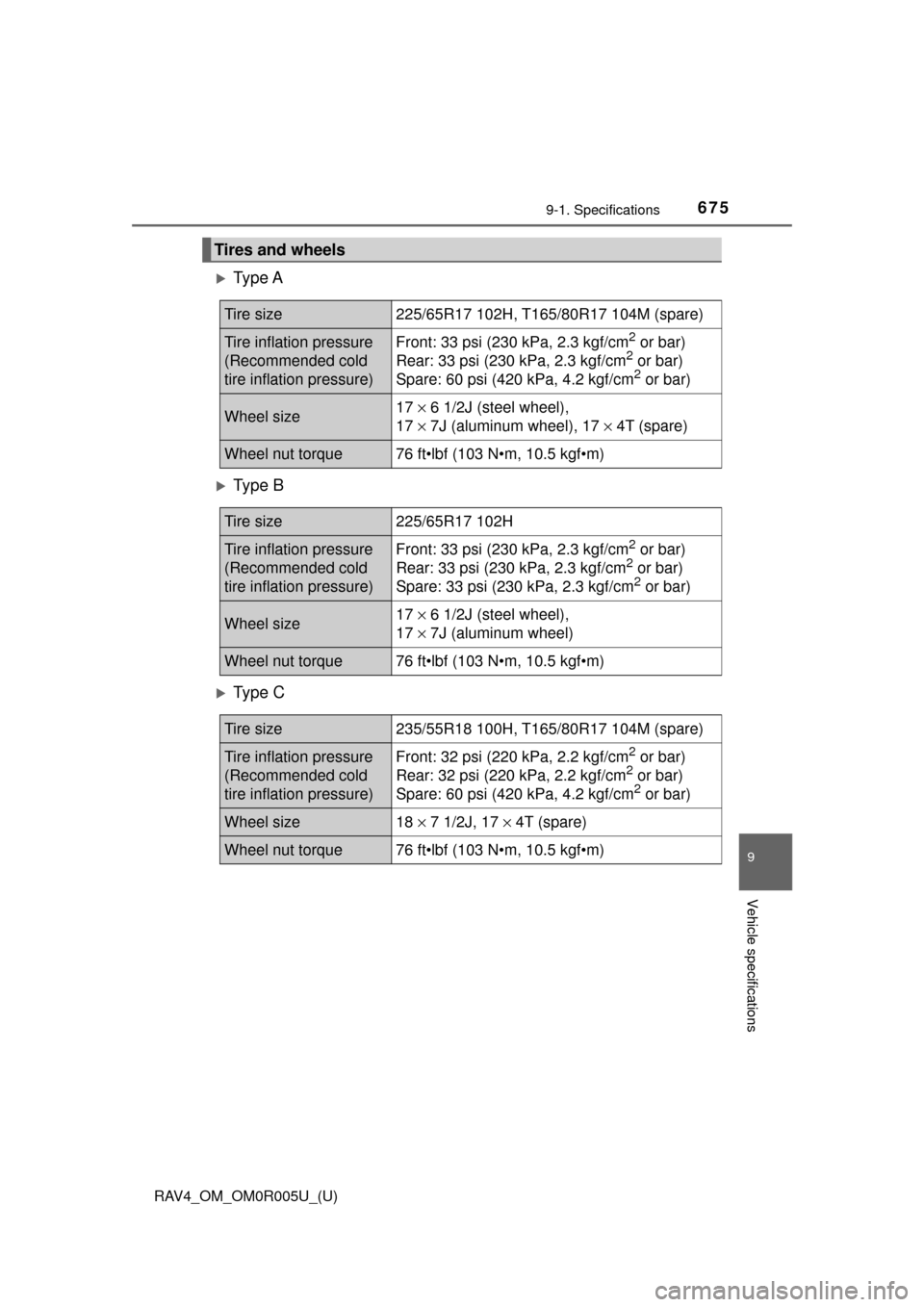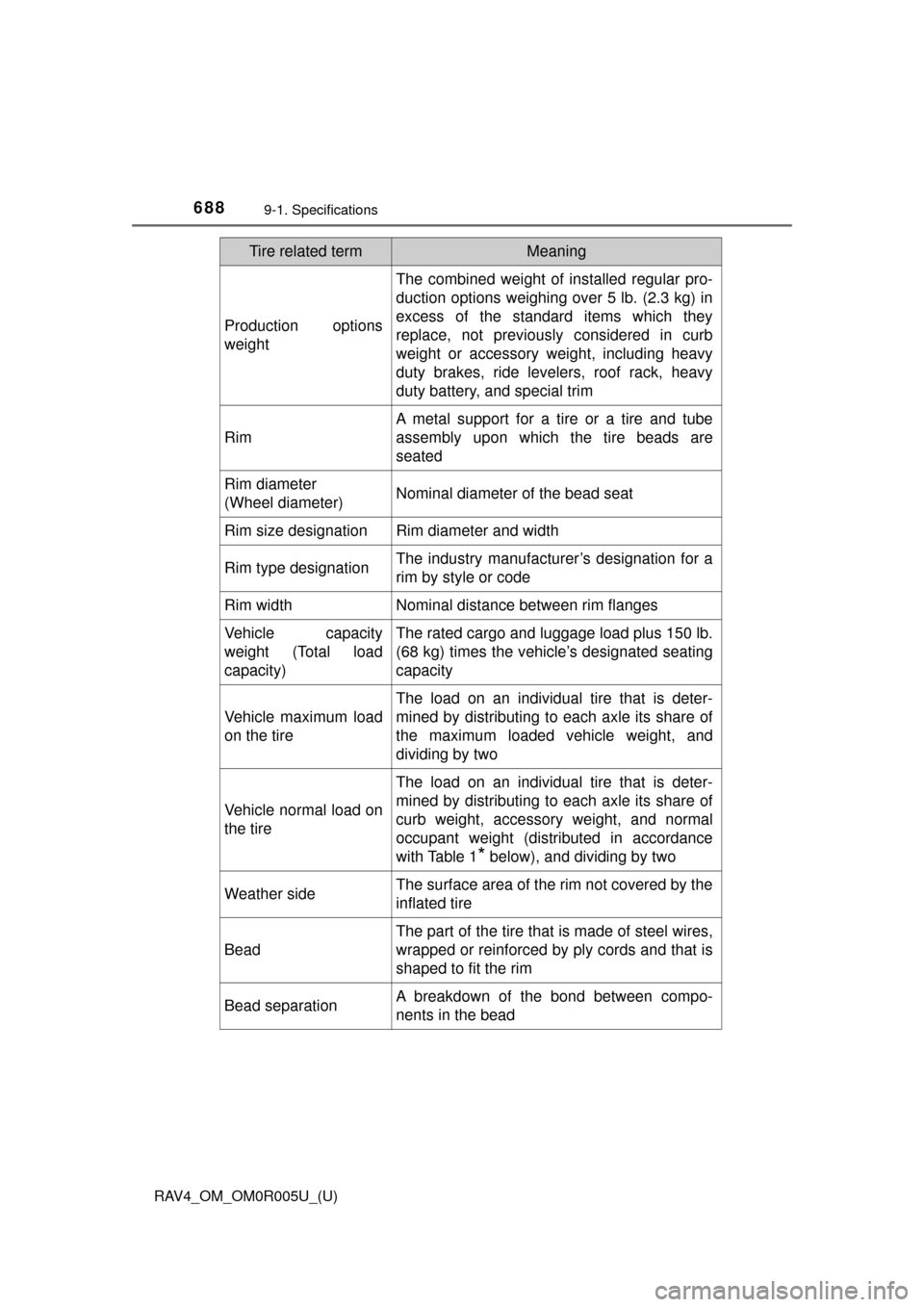Page 654 of 741
6538-2. Steps to take in an emergency
RAV4_OM_OM0R005U_(U)
8
When trouble arises
NOTICE
■Be careful when driving over bumps with the compact spare tire
installed on the vehicle. (if equipped)
The vehicle becomes lower when driving with the compact spare tire
compared to when driving with standard tires. Be careful when driving
over uneven road surfaces.
■Driving with tire chains and the compact spare tire (if equipped)
Do not fit tire chains to the compact spare tire.
Tire chains may damage the vehicle body and adversely affect driving
performance.
■When replacing the tires (vehicles with the tire pressure warning
system)
When removing or fitting the wheels, tires or the tire pressure warning
valve and transmitter, contact your Toyota dealer as the tire pressure
warning valve and transmitter may be damaged if not handled correctly.
Page 666 of 741
665
RAV4_OM_OM0R005U_(U)
8-2. Steps to take in an emergency
8
When trouble arises
If the vehicle becomes stuck
Stop the engine. Set the parking brake and shift the shift lever to P.
Remove the mud, snow or sand from around the stuck tire.
Place wood, stones or some other material to help provide traction
under the tires.
Restart the engine.
AWD models: Activate all-wheel drive lock mode. (→P. 296)
Shift the shift lever to D or R and release the parking brake. Then,
while exercising caution, depress the accelerator pedal.
■ When it is difficult to free the vehicle
Press to turn off TRAC.
Carry out the following procedures if the tires spin or the vehicle
becomes stuck in mud, dirt or snow:
1
2
3
4
5
6
2WD models
AWD models
Page 667 of 741
6668-2. Steps to take in an emergency
RAV4_OM_OM0R005U_(U)
WARNING
■When attempting to free a stuck vehicle
If you choose to push the vehicle back and forth to free it, make sure the
surrounding area is clear to avoid striking other vehicles, objects or people.
The vehicle may also lunge forward or lunge back suddenly as it becomes
free. Use extreme caution.
■ When shifting the shift lever
Be careful not to shift the shift lever with the accelerator pedal depressed.
This may lead to unexpected rapid acceleration of the vehicle that may
cause an accident resulting in death or serious injury.
NOTICE
■To avoid damaging the transmission and other components
● Avoid spinning the wheels and depressing the accelerator pedal more
than necessary.
● If the vehicle remains stuck even after these procedures are performed,
the vehicle may require towing to be freed.
Page 669 of 741
668
RAV4_OM_OM0R005U_(U)
9-1. Specifications
Maintenance data (fuel, oil level, etc.)
*1: Unladen vehicle
*2: Vehicles with raised vehicle height
*3: Vehicles for trailer towing ( →P. 181)
Dimensions and weights
Overall length
Vehicles without
front license plate
garnish
181.1 in. (4600 mm)
Vehicles with front
license plate gar-
nish
181.3 in. (4605 mm)
Overall width72.6 in. (1845 mm)
Overall height*1
Without the roof
luggage carrier65.9 in. (1675 mm)
66.3 in. (1685 mm)
*2
With the roof lug-
gage carrier67.1 in. (1705 mm)
67.5 in. (1715 mm)
*2
Wheelbase104.7 in. (2660 mm)
Front and rear
tread17-inch tires61.8 in. (1570 mm)
18-inch tires61.4 in. (1560 mm)
Vehicle capacity weight
(Occupants + luggage)900 lb. (410 kg)
Trailer Weight Rating *3
(Trailer weight + cargo weight)1500 lb. (680 kg)
Page 676 of 741

RAV4_OM_OM0R005U_(U)
6759-1. Specifications
9
Vehicle specifications
Ty p e A
Ty p e B
Ty p e C
Tires and wheels
Tire size225/65R17 102H, T165/80R17 104M (spare)
Tire inflation pressure
(Recommended cold
tire inflation pressure)Front: 33 psi (230 kPa, 2.3 kgf/cm2 or bar)
Rear: 33 psi (230 kPa, 2.3 kgf/cm2 or bar)
Spare: 60 psi (420 kPa, 4.2 kgf/cm2 or bar)
Wheel size17 × 6 1/2J (steel wheel),
17 × 7J (aluminum wheel), 17 × 4T (spare)
Wheel nut torque76 ft•lbf (103 N•m, 10.5 kgf•m)
Tire size225/65R17 102H
Tire inflation pressure
(Recommended cold
tire inflation pressure)Front: 33 psi (230 kPa, 2.3 kgf/cm2 or bar)
Rear: 33 psi (230 kPa, 2.3 kgf/cm2 or bar)
Spare: 33 psi (230 kPa, 2.3 kgf/cm2 or bar)
Wheel size17 × 6 1/2J (steel wheel),
17 × 7J (aluminum wheel)
Wheel nut torque76 ft•lbf (103 N•m, 10.5 kgf•m)
Tire size235/55R18 100H, T165/80R17 104M (spare)
Tire inflation pressure
(Recommended cold
tire inflation pressure)Front: 32 psi (220 kPa, 2.2 kgf/cm2 or bar)
Rear: 32 psi (220 kPa, 2.2 kgf/cm2 or bar)
Spare: 60 psi (420 kPa, 4.2 kgf/cm2 or bar)
Wheel size18 × 7 1/2J, 17 × 4T (spare)
Wheel nut torque76 ft•lbf (103 N•m, 10.5 kgf•m)
Page 684 of 741
RAV4_OM_OM0R005U_(U)
6839-1. Specifications
9
Vehicle specifications
■Typical tire size information
The illustration indicates typical
tire size.
Tire use
(P = Passenger car,
T = Temporary use)
Section width (millimeters)
Aspect ratio
(tire height to section width)
Tire construction code (R = Radial, D = Diagonal)
Wheel diameter (inches)
Load index (2 digits or 3 digits)
Speed symbol (alphabet with one letter)
■Tire dimensions
Section width
Tire height
Wheel diameter
Tire size
1
2
3
4
5
6
7
1
2
3
Page 687 of 741
686
RAV4_OM_OM0R005U_(U)
9-1. Specifications
■Temperature A, B, C
The temperature grades are A (the highest), B, and C, representing
the tire’s resistance to the generation of heat and its ability to dissi-
pate heat when tested under co ntrolled conditions on a specified
indoor laboratory test wheel.
Sustained high temperature can c ause the material of the tire to
degenerate and reduce tire life, and excessive temperature can lead
to sudden tire failure.
Grade C corresponds to a level of performance which all passenger
car tires must meet under the Federal Motor Vehicle Safety Stan-
dard No. 109.
Grades B and A represent higher levels of performance on the labo-
ratory test wheel than the minimum required by law.
Warning: The temperature grades of a tire assume that it is properly
inflated and not overloaded.
Excessive speed, underinflation, or excessive loading, either sepa-
rately or in combination, can cause heat buildup and possible tire
failure.
Page 689 of 741

688
RAV4_OM_OM0R005U_(U)
9-1. Specifications
Production options
weight
The combined weight of installed regular pro-
duction options weighing over 5 lb. (2.3 kg) in
excess of the standard items which they
replace, not previously considered in curb
weight or accessory weight, including heavy
duty brakes, ride levelers, roof rack, heavy
duty battery, and special trim
Rim
A metal support for a tire or a tire and tube
assembly upon which the tire beads are
seated
Rim diameter
(Wheel diameter)Nominal diameter of the bead seat
Rim size designationRim diameter and width
Rim type designationThe industry manufacturer’s designation for a
rim by style or code
Rim widthNominal distance between rim flanges
Vehicle capacity
weight (Total load
capacity)The rated cargo and luggage load plus 150 lb.
(68 kg) times the vehicle’s designated seating
capacity
Vehicle maximum load
on the tire
The load on an individual tire that is deter-
mined by distributing to each axle its share of
the maximum loaded vehicle weight, and
dividing by two
Vehicle normal load on
the tire
The load on an individual tire that is deter-
mined by distributing to each axle its share of
curb weight, accessory weight, and normal
occupant weight (distributed in accordance
with Table 1
* below), and dividing by two
Weather sideThe surface area of the rim not covered by the
inflated tire
Bead
The part of the tire that is made of steel wires,
wrapped or reinforced by ply cords and that is
shaped to fit the rim
Bead separationA breakdown of the bond between compo-
nents in the bead
Tire related termMeaning